Gas Saver Gets a Midcycle Refresh
Kia has been good about offering “Neopolitan” choices for a few of its models. In ice cream, Neopolitan means chocolate, vanilla and strawberry. With a Kia Niro, it means Hybrid, Plug-in Hybrid, and pure EV. If the flavors are laid out that way, it would be the “vanilla” selection—the PHEV—that visited my driveway recently.
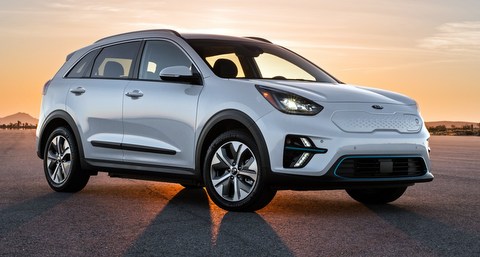
I have sampled the other flavors of Niro. The hybrid, like all other hybrids, is a way to drive further on less gas, thanks to an electric motor that automatically regenerates power from regenerative braking and stores it in a small battery. There’s no effort required on the driver’s part. With the all-electric model, the Niro challenges other EVs with a high level of equipment and a terrific 239-mile range in a crowd-pleasing SUV shape.
As a PHEV, the 2020 Kia Niro Plug-in Hybrid offers significantly more electric range than the hybrid, but is still lugging around a gas tank, engine, radiator, etc., which you’ll need when you want to drive more than 26 miles without charging up. However, you can drive anywhere you want to, anytime.
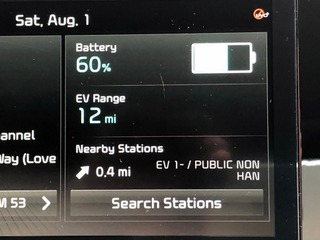
track of how far you want to go
As they say in the software business, it depends on your “use case.” If you travel long distances a lot, a hybrid is a no-brainer. The plug-in hybrid is great if you occasionally want to drive hundreds of miles unimpeded by a charging stop, but you get nearly full-electric motoring for your short trips around town. The EV is the most environmentally friendly, and you can go over 200 miles before needing an electron fill-up, but charging still takes time.
Different and the Same
The beauty is, all three versions look and drive about the same. The EV is missing the 1.6-liter, 139-horsepower engine and six-speed automatic dual clutch transmission, and its 64-kilowatt-hour (kWh) battery is much larger and heavier than the one in the PHEV. The PHEV, like my Horizon Blue tester, has a much smaller 8.9 kWh lithium-ion polymer battery for its more modest range, so it’s in the middle somewhere (the hybrid battery is smaller still at 1.56 kWh).
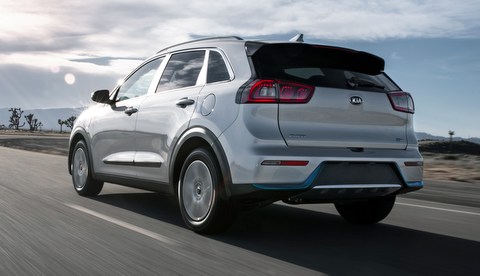
You can spec the PHEV at the LXS, EX, or EX Premium level. My tester was the EX Premium, so it came with some extras that even the regular EX didn’t get. These include a 10.25-inch dash screen instead of the standard 8.0-inch, a power tilt/slide sunroof, a Harman Kardon 8-speaker upgraded audio system, heated artificial leather seats (new this year), LED interior cabin and cargo lighting, deluxe scuff plates and more.
The driving experience for the 2020 Kia Niro PHEV is pleasant, as it cruises silently around town on electricity. The engine comes in when you run out of juice, but during my COVID-19-reduced driving regimen, I rarely heard it. What I did hear, though, was a strange artificial swishing sound below around 20 miles per hour. This is provided to alert oblivious pedestrians, who can’t hear the electric motor in parking lots.
Subtle Design Changes
The design of the 2020 Kia Niro PHEV owes something to the hand and the vision of former Audi stylist Peter Schreyer. He has been at Kia for a while now, so a satisfying balance and distinctive look is now part of all Kia products. For 2020, the instrument panel gets an update, but without a 2019 next to it, I can’t say what’s different.
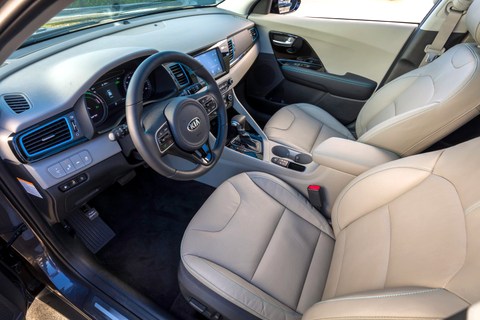
Inside, the controls are typical Kia—easy to use and understand. The oversize screen in my tester featured large displays, and setting up Apple CarPlay was a snap. The leather-wrapped wheel feels nice, the seats are comfortable, and it’s all carefully planned to make driving nearly effortless.
The exterior receives midcycle grille and fascia upgrades up front and some upgrades to the tail, too, but nothing too different. This is a nice-looking, if not eye-popping vehicle, so there was no reason to mess with that.
The Numbers Game
Environmentally speaking, the 2020 Kia Niro PHEV gets fuel economy numbers of 48 mpg city/44 highway/46 combined as a hybrid. As a plug-in, it’s rated 105 MPGe (miles per gallon equivalent) if you charge it up. A full charge from zero on Level 2 240-volt current takes about two hours and 15 minutes.
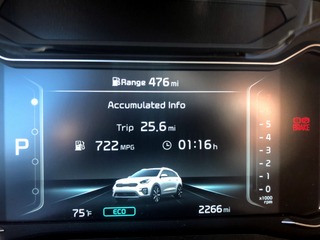
The EPA green scores are 7 for Smog and a perfect 10 for Fuel Economy/Greenhouse Gas. The Niro PHEV emits just 90 grams of CO2 per mile, which isn’t very much considering some gasoline vehicles I’ve tested spew out well over 300. The more you use the battery, the lower that actual number will be, of course.
Prices, including shipping, start at $30,610 for the LXS and range up through the EX at $34,350 and EX Premium at $37,510. My tester came to $37,790 with additional cargo mats and net.
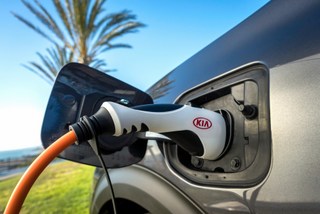
Unlike some Hyundais and Kias, which are built in the U.S., this one is assembled in Hwasung, Korea. These days that doesn’t really mean much, but now you know.
As a reasonably roomy, high-utility crossover, any Kia Niro is a perfect choice for many people. You pick the battery size for what suits you.
Story by Steve Schaefer; photos by Steve Schaefer and the manufacturer.
Make sure to opt-in to the Clean Fleet Report newsletter (top right of page) to be notified of all new stories and vehicle reviews.
Related Stories You Might Enjoy—Growing Crossover Plug-in Options
Flash Drive 2021 Toyota RAV4 Prime
News: Cadillac Sings a New Tune with Lyriq
News: Nissan Introduces Electric Crossover
Road Test: 2020 Hyundai Kona EV
Road Test: 2020 Kia Niro EV
Road Test: 2020 BMW X3 xDrive30e
News: Audi Adds Q4 E-Tron Sportback to Plug-In Portfolio
News: Ford’s Mach-E: Selling Car Buyers on Going Electric
News: Ford Releases Details on Plug-In Hybrid Escape
News: Fisker Ocean Electric SUV Debuts
Disclosure:
Clean Fleet Report is loaned free test vehicles from automakers to evaluate, typically for a week at a time. Our road tests are based on this one-week drive of a new vehicle. Because of this we don’t address issues such as long-term reliability or total cost of ownership. In addition, we are often invited to manufacturer events highlighting new vehicles or technology. As part of these events we may be offered free transportation, lodging or meals. We do our best to present our unvarnished evaluations of vehicles and news irrespective of these inducements.
Our focus is on vehicles that offer the best fuel economy in their class, which leads us to emphasize electric cars, plug-in hybrids, hybrids and diesels. We also feature those efficient gas-powered vehicles that are among the top mpg vehicles in their class. In addition, we aim to offer reviews and news on advanced technology and the alternative fuel vehicle market. We welcome any feedback from vehicle owners and are dedicated to providing a forum for alternative viewpoints. Please let us know your views at publisher@cleanfleetreport.com.

4 thoughts on “Road Test: 2020 Kia Niro Plug-in Hybrid”